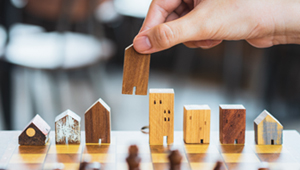Reverse 1031 Exchanges: A Closer Look at the Benefits & Implications

Introduction
One of the most advantageous features of American tax law is the 1031 tax deferred exchange clause. There are similar mechanisms to the 1031 exchange, but the reverse 1031 exchange is a unique way to give you more control in the competitive commercial real estate niche. Interest rates have risen quickly, which has affected how transactions are financed and closed. Despite this challenging environment, investors still use 1031 Exchanges to ensure they don’t pay too much in taxes. However, some investors have had trouble using a “Forward” 1031 Exchange because their buyer needs more time to close the deal. A “Reverse” 1031 Exchange involves buying and parking the new property with a qualified intermediary until the old property is sold. This allows the investor to defer taxes on the profit from selling the old property while still buying the new property they want. Reverse 1031 exchanges can be more complicated than regular 1031 exchanges and require careful understanding, planning, and implementation. The reverse 1031 exchange can be a helpful tool for investors who want to buy a replacement property before it becomes available on the market or who want to reduce the risk of an exchange failing since it may be challenging to find a replacement property within the required timeframe.
What is 1031 Exchange?
Using a 1031 exchange, commercial real estate listing owners can defer paying capital gains taxes (the tax levied on the profit or gain realized from the sale of the property) while selling an investment property by reinvesting the sale profits from one investment property into another. This may help the investors to expand their investment portfolio more quickly. The investor may eventually have to pay capital gains taxes if they sell the replacement property without executing another 1031 exchange. Therefore, it’s crucial to understand that a 1031 exchange is not tax-free. According to the Internal Revenue Code, the property sold and purchased must meet specific standards. Such as:
Property Type: One of the requirements that properties must have to be qualified for 1031 exchange is that both of the properties (property being sold and the property being purchased) should be “like-kind” and the properties need to be used productively in a trade or business or for investment purposes. This means that the nature or characteristics of these properties should be similar even though the grade or quality is different. For example, an office building or apartment complex might be exchanged for a property like a retail store and produce similar rental income.
Hold time: Before exchange, a property must have been held for commercial real estate investment, trade, or business purposes for at least 24 months.
Proceeds Reinvestment: The sales proceeds from the old property must be reinvested into the new property. The replacement property should be of equal or greater value to defer taxes.
Timeline: It is required to identify the replacement property within 45 days of the sale of the original property. Moreover, the exchange must be finished within 180 days.
Intermediary: A qualified intermediary is required to facilitate the exchange where the intermediary holds the proceeds from the sale of the original property and uses them to purchase the replacement property.
What is Reverse 1031 Exchange?
In a 1031 exchange, the commercial real estate investor first sells the old property and then identifies and buys a new property within 180 days, using the proceeds from the sale of the old property. The taxes on the profit from the sale of the old property are deferred as long as the new property is of equal or greater value than the old property. In a reverse 1031 exchange, the investor identifies and purchases a new property and then sells the old one within 180 days. The new property is “parked” with a qualified intermediary until the old property is sold. The taxes on the profit from the sale of the old property are deferred as long as the new property is purchased within 45 days and the old property is sold within 180 days. An Exchange Accommodation Titleholder (EAT) retains ownership of the replacement or relinquished property during a reverse 1031 exchange until the transaction is finished. To perform a reverse 1031 exchange, a person must follow the established time frame the Internal Revenue Service (IRS) allows. Although many of the rules of reverse 1031 exchange are similar to the traditional 1031 exchange, some rules are different and more complex than the conventional 1031 exchange. For this reason, it is vital to work with a qualified intermediary to complete this complicated process smoothly. Before considering a reverse 1031 exchange, one should know the following facts:
– The IRS does not permit the title to be held simultaneously for the replacement and the unrelinquished properties. It requires an Exchange Accommodation Titleholder (EAT) to have the relinquished or replaced property title throughout the exchange process. The EAT is a qualified intermediary (QI) or a unique body formed by agreeing to a suitable exchange accommodation agreement.
– The taxpayer must identify the relinquished property within 45 days of purchasing the replacement property.
– The taxpayer has 180 days from buying the new property to selling the property they’ve relinquished.
– Similar to the traditional 1031 exchange rule, the replacement and relinquished property should be “like-kind.”
Need help structuring your exchange? Let’s talk!
Schedule a Discovery CallDifference Between 1031 Exchange & Reverse 1031 Exchange
Taking advice from a commercial realtor, if an investor wants to buy multiple properties, they can combine Forward and Reverse exchange mechanisms to get the benefits of maximum tax deferral. By parking the new properties, the investor can use exchange funds to improve them before buying them. A qualified intermediary can also make sure the investor’s money is safe and can help them with the exchange process. Notably, 1031 intermediaries aren’t regulated in most states, so investors need to be careful about who they choose to work with. Let’s say you want to sell a property you own and use the money to buy a new one. If you just sell the old property and use the money to buy the new property, you would have to pay taxes on any profit you made from selling the old property. But if you do a “1031 exchange,” you can defer paying those taxes. In a traditional 1031 exchange, you would first sell your old property and then use the money to buy the new property within a specific time frame. This allows you to defer paying taxes on the profit you made from selling the old property. However, sometimes, the buyer of your old property might need more time to close the deal, which could delay your purchase of the new property. If you don’t want to lose the opportunity to buy the new property and still defer paying taxes on the profit from selling the old property, you could do a “reverse 1031 exchange.” The following table will clarify:
| Aspect | 1031 Exchange | Reverse 1031 Exchange |
|---|---|---|
| Definition | In a tax-deferred exchange, an investor sells one property and purchases another like-kind property. | An exchange where an investor purchases a like-kind property before selling their current property. |
| Order of Transactions | Sell the current property first, then buy replacement property. | Buy replacement property first, then sell the current property. |
| Timing Limitation | Investors have 45 days to identify replacement property and 180 days to close the sale. | Investors have 45 days to identify the relinquished property and 180 days to close the sale of the old property. |
| Funding | Uses the proceeds from the relinquished property to purchase the replacement property. | Investors use cash, commercial real estate loans, or other sources to finance the replacement property first |
| Example | An investor sells an office building for $1 million and uses the proceeds to purchase a retail store for $1.5 million within the designated time frame. | An investor purchases a warehouse for $2 million and parks it with a qualified intermediary while selling their office building property for $1.5 million. Once the office building is sold, the intermediary uses the proceeds to complete the warehouse purchase. |
| Benefits | Defer capital gains tax and potentially state tax | Allow investors to take advantage of market opportunities without risking losing the tax benefits of a 1031 exchange. |
Parking Approaches to Structure a Reverse 1031 Exchange
Under Revenue Procedure 2000-37, the Exchanger cannot simultaneously own the replacement and relinquished properties. Thus, EAT holds the property title while a reverse 1031 exchange is ongoing. This technique is known as ‘Parking.’ Regardless of which property is parked, the Exchanger has access to it. Between the EAT and the Exchanger, a commercial property for lease and management agreement QEAA (Qualified Exchange Accommodation Agreement) is signed so that the Exchanger has full access to the parked property.
Two parking approaches can be used to structure a reverse 1031 exchange. They are:
Park Replacement Property Approach: The Exchanger acquires replacement property using the Exchange Accommodation Titleholder (EAT). Until the Exchanger sells their current property, the EAT keeps the title to the replacement property. The EAT transfers the title of the replacement property to the Exchanger once the Exchanger sells their relinquished property.
Park Relinquished Property Approach: The EAT will take the title of the relinquished property. The EAT acquires the replacement property and swaps it simultaneously with the relinquished property of the Exchangor. The EAT keeps ownership of the relinquished property until a buyer is found. When the relinquished property is sold, EAT transfers the title to the buyer of the relinquished property.
Advantages & Drawbacks of Reverse 1031 Exchange
Some key advantages of reverse 1031 exchange are discussed below:
– A reverse 1031 allows Exchangers to acquire the right replacement property at the ideal price and timing.
– Investors might use favorable market conditions to locate the perfect replacement property instead of hastily listing their current property.
– Investors have more liberty to diversify their real estate holdings with a reverse exchange. Reverse 1031 exchange allows investors to acquire a replacement property with another type of client or use it in a different place.
– The “non-safe harbor” Reverse Exchange may offer more time if 180 days are insufficient.
– Combining the Forward and Reverse Exchange models can optimize the tax deferral if an investor plans to buy more than one Replacement Property, some of which might close before the relinquished property and others after the sale.
– The risk of failure is low since the replacement property is acquired before the relinquished property is sold in a reverse 1031 exchange. The Exchanger can focus only on selling the relinquished property in the permitted timeline of 180 days without having the pressure of finding a replacement property.
To comply with IRS regulations, some unique requirements and challenges must be handled to complete the reverse 1031 exchange. There are several reasons why reverse 1031 exchanges are more complex.
They are:
Time factor: In a reverse 1031 exchange, an investor purchases the replacement property before selling the relinquished property and gets a strict time limit to complete the exchange procedure.
Less Flexible: Compared to a traditional 1031 exchange, a reverse 1031 exchange might need to be more flexible. For instance, commercial property investors are not permitted to use the sales proceeds of their existing property. As a result, there are few options to finance the replacement property.
Higher Cost: The reverse 1031 exchange is more costly than the traditional 1031 exchange since it requires setting up a single-purpose entity (SPE) to hold the replacement property, which can be expensive. It is a legal entity created for a specific purpose, typically to hold title to the replacement property during the exchange process. The SPE is owned and controlled by the taxpayer or an intermediary, allowing the taxpayer to acquire the replacement property before selling their relinquished property. However, using an SPE in a reverse 1031 exchange can help mitigate specific risks and ensure that the transaction complies with IRS regulations.
Risks & Complexity: This kind of exchange may be risky since it requires acquiring the replacement property before selling the existing property. This means the investor is holding both the existing and replacement property simultaneously. The investor may be obligated to keep two properties, which can be expensive if they fail to sell their current property. Investors require the help of a qualified intermediary and other professionals, which can increase the time and cost of the transaction.
Commercial Property Management Challenges: When a reverse 1031 exchange is ongoing, the investor must manage both properties simultaneously. It can be logistically challenging for the investor to manage two properties. For instance, they may be required to finance both properties, adding to their debt burden and requiring more cash flow to pay for regular expenditures.
Conclusion
Reverse 1031 exchange has benefits and drawbacks; thus, it is crucial to consider these facts carefully to avoid exchange failure. In a reverse 1031 exchange, you would buy the new property first and then sell the old property. This allows you to defer paying taxes on the profit from selling the old property while still being able to buy the new property you want. But there’s a catch: you can’t technically own two properties simultaneously. So, in a reverse 1031 exchange, you would need to park the new property with a qualified intermediary, who would hold onto it until you sell the old property. Once you sell the old property, you can then officially buy the new property from the intermediary and complete the exchange. This might sound complicated, but it can be a valuable strategy for investors who want to take advantage of an excellent opportunity to buy a new property while still deferring taxes on the profit from selling an old property. Since this kind of exchange is more complex than the traditional 1031 exchange and many rules and regulations must be followed, it is always advised to consult with a qualified commercial property broker to ensure all the requirements are met and all the rules are correctly followed.
Topic: Reverse 1031 Exchanges
Is a reverse 1031 exchange right for your investment strategy?
Talk to a Broker
About the Author - Adam Stephenson, CCIM, SIOR
With over a decade of experience in commercial real estate, Adam is a trusted advocate for privately held organizations, specializing in industrial properties across Central Indiana. Adam brings a wealth of expertise in tenant representation, lease negotiations, and strategic asset acquisitions. A graduate of Indiana University – Indianapolis with a degree in Business Management, he further distinguished himself by earning the prestigious CCIM & SIOR designations. His deep industry knowledge, client-focused approach, and commitment to delivering tailored solutions make his insights invaluable.
Download Our Free Resource:
2025 Edition - CRE Forecast:
Trends And Predictions For CRE.

You might also enjoy reading:
Cookies improve your browsing experience, deliver tailored ads or content, and assess our website traffic. If you click 'Accept All’ you are giving your consent for us to utilize cookies. Check our cookies policy here.
Adding {{itemName}} to cart
Added {{itemName}} to cart





















